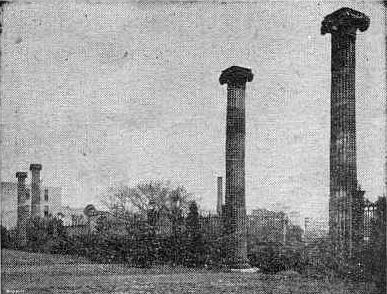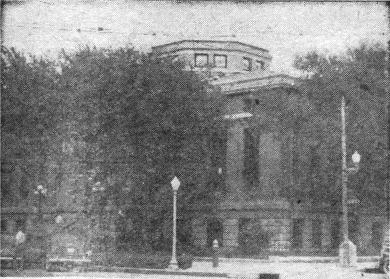

No. 9--O Street Columns Hats off! The flag... ! Shade your eyes down this vista and summon your imagination. Do you see falling across these columns, the shadow of a great president and hear out of the past the distant marching of feet and the sound of muted fife and drum?
These columns at the 0 street entrance of Antelope park, between 23rd and 24th. were once a part of the old federal building in Washington. Standing between them Abraham Lincoln once reviewed the Civil war troops. Easterners, who live in an atmosphere crowded with reminders of the historic great, would smile at such a thin fancy--at attempting somehow to draw Abraham Lincoln across the Missouri river. So far as history shows, the east bank of the Missouri in as far west as Lincoln ever traveled. In the early years of the 60's he was the guest of Gen. Dodge in Council Bluffs, invited there to help decide where the eastern terminal of the Union Pacific should be. As we recall an early account, Lincoln stood on the bank of the Missouri and gazed westward, but even "on a clear day" such as we like to boast of from the Missouri on west, he could hardly have seen the little village which later would bear his name.
When the treasury building was remodeled in 1907 these sandstone columns were bought by Cotton T. Bride of Washington, a personal friend of William Jennings Bryan. He presented them to the city of Lincoln in 1916.
Halfway between the columns is a bronze tablet relating the origin of the pillars. The tablet, weighing 450 pounds and made from material saved from the battle ship Maine, was presented to the city by the U. S. W. V.

No. 10 City Library Of the 2811 libraries which Andrew Carnegie magnanimously scattered over this globe before his death in 1919, five stand in Lincoln--a generous proportion, surely. Perhaps we would not have shared his bounty so fully had it not been that libraries in University Place, College View and Havelock were secured when these sections of Lincoln were still towns in their own right.
Before Mrs. W. J. Bryan interceded to secure a Carnegie building for Lincoln proper the library was as wandering an a poor sharecropper, and burned out about as often. It ceased its nomadic life in 1900, beginning in that year a dignified and permanent existence at Fourteenth and N.
We have it from the librarian, Magnus Kristoffersen, that an many as 2,000 people have been known to walk up the library steps in one day to take out books or to linger and read. That sounds like a great many people and it probably doesn't happen often. Even so, the library is doubtless one of the city's valuable assets. The building is richly lined with 160,000 volumes, written by the great, the near great or the fleetingly great authors of all time. No wonder readers come often to draw mental and spiritual sustenance therefrom.
An attentive staff and a carefully worked system make access to books easy at any of the library buildings. Two branches not mentioned above are Northeast at 27th and Orchard and Bethany at 1551 No. Cotner.
Any Lincoln resident, any child attending Lincoln schools, anyone attending college here or anyone owning property and paying taxes to the city will be issued a borrower's card, good at any of the city's libraries. In addition to regular activities, service is given the three principal Lincoln hospitals. A still newer feature is the bookmobile, which makes five stops in the city.
© 2000, 2001 by Kathie Harrison, Ted & Carole Miller